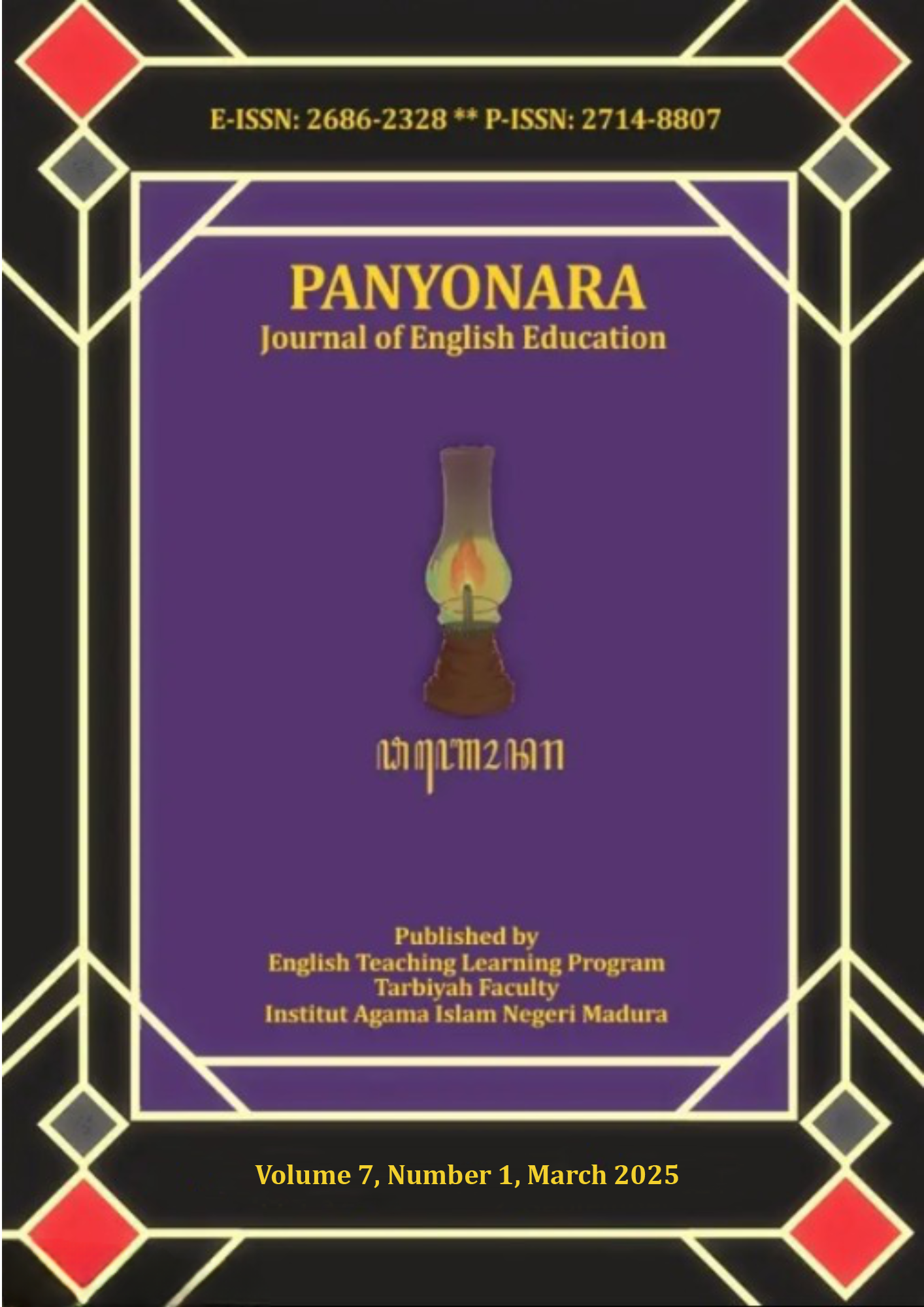Language Preferences in Note-Taking for Consecutive Interpreting: Insights from Indonesian EFL Students
 Abstract views: 37
,
Abstract views: 37
,
 PDF downloads: 32
PDF downloads: 32
Abstract
In the dynamic field of consecutive interpreting, language choice in note-taking is a critical skill that bridges cognitive processing and ensures the accurate delivery of messages. The present small-scale study investigates the language choice in note-taking for consecutive interpreting practices among Indonesian EFL (English as a Foreign Language) students. This aims to determine whether the students prefer to take notes in English or Indonesian when interpreting between these two languages and to reveal the reasons behind their preferences. This study employed a case study design, analyzing 45 note-taking samples, followed by conducting face-to-face interviews with 4 students to gain a deeper understanding. The findings reveal a significant preference for taking notes in English, irrespective of the direction of interpreting. This preference highlights the students’ inclination towards using English as a medium for cognitive processing and information retention in consecutive interpreting tasks. The results suggest that English proficiency plays a crucial role in the note-taking strategies adopted by Indonesian EFL students. These insights can inform teaching methodologies and curriculum design in interpreter training programs, emphasizing the importance of English proficiency in enhancing interpreting skills.
Downloads
References
Adler, A. (2023). Cognitive Load in Dialogue Interpreting: Experience and Directionality [Doctoral Dissertation]. Stockholm University.
Alexieva, B. (1994). On Teaching Note-Taking in Consecutive Interpreting. In Teaching Translation and Interpreting 2 (p. 199). Oxford: John Benjamins.
Błaszczyk, P., & Hanusiak, D. (2010). The Choice of Language for Note-taking for Consecutive Interpreting: A Polish Perspective. Mikael: Kääntämisen Ja Tulkkauksen Tutkimuksen Aikakauslehti, 4. 1-10. https://doi.org/10.61200/mikael.129666
Bóna, J., & Bakti, M. (2020). The Effect of Cognitive Load on Temporal and Disfluency Patterns of Speech: Evidence from Consecutive Interpreting and Sight Translation. Target, 32(3), 482–506. https://doi.org/10.1075/target.19041.bon
Bowen, D., & Bowen, M. (1984). Steps to Consecutive Interpretation. Washington: Pen & Booth.
Dam, H. V. (2004). Interpreters’ Notes. Interpreting. International Journal of Research and Practice in Interpreting, 6(1), 3–17. https://doi.org/10.1075/intp.6.1.03dam
Durban, C. (2011). Interpreting Getting it Right. Alexandria: American Translators Association.
Emilia, E., Septaviana, S. R., & Abdullah, H. (2011). A Fresh Look at Student’s Note-taking in Consecutive Interpreting: A Case in Indonesia. Translingua, Journal of Translation Studies, 15(1), 1-22.
Gile, D. (2009). Basic Concepts and Models for Interpreter and Translator Training. Amsterdam: John Benjamins.
Ginori, L., & Scimone, E. (1995). Introduction to Interpreting. Sydney: Latern.
Hanusiak, D. (2021). The Choice of Language for Note-taking for the Purposes of Consecutive Interpreting. Między Oryginałem a Przekładem, 27(4(54)), 51–61. https://doi.org/10.12797/MOaP.27.2021.54.03
Jones, R. (1998). Conference Interpreting Explained. Manchester: St. Jerome.
Lee, J., & Buzo, A. (2009). Community Language Interpreting: A Workbook. Sydney: Federation Press.
Liu, Y., Luo, W., & Wang, X. (2023). Exploring the Relationship Between Students’ Note-Taking and Interpreting Quality: A Case Study in the Chinese Context. Frontiers in Education, 8, 1157509. https://doi.org/10.3389/feduc.2023.1157509
Phelan, M. (2001). The Interpreter’s Resource (Vol. 19). Clevedon: Multilingual Matters.
Phuong, H. Y., Lam, T. C. T., & Le, T. T. (2023). Students’ Perceptions of Using Note-Taking in Consecutive Interpreting Assignments. CTU Journal of Innovation and Sustainable Development, 15(1), 8–21. https://doi.org/10.22144/ctu.jen.2023.002
Pöchhacker, F. (2016). Introducing Interpreting Studies (2nd ed). New York: Routledge, Taylor & Francis.
Riccardi, A. (2002). Translation Studies: Perspective on an Emerging Discipline. Cambridge: Cambridge University Press.
Rozan, J. (2002). Note-taking in Consecutive Interpreting (tr. A. Gillies/B.Hrehorowicz). Kraków: Tertium.
Saehu, A. (2024). Interpreting: Teori dan Praktik. Bandung: Nuansa Cendekia. https://books.google.co.id/books?id=99QEEQAAQBAJ
Shuttleworth, M., & Cowie, M. (1997). Dictionary of Translation Studies. Manchester: St. Jerome.
Sneddon, J. N., Adelaar, K. A., Djenar, D., & Ewing, M. (2012). Indonesian: A Comprehensive Grammar. Routledge. https://doi.org/10.4324/9780203720882
Szabó, C.-A. (2006). Language Choice in Note-Taking for Consecutive Interpreting. Interpreting. International Journal of Research and Practice in Interpreting, 8(2), 129–147. https://doi.org/10.1075/intp.8.2.02sza
Taylor-Bouladon, V. (2007). The Interpreter’s Guide to Success. Bloomington: Trafford Publishing.
Turner, B. (2009). Automatisation in Note-Taking for Consecutive Interpreting. A Handout of Presentation in a Training on “Note-Taking for Consecutive Interpreting” Organised by Himpunan Penerjemah Indonesia (Association of Indonesian Translators). Jakarta, 29 March, 2009.
Wang, C. (2023). Strategies for Note-taking in Consecutive Interpreting: A Case Study Based on Effort Model. Lecture Notes on Language and Literature, 6(2), 51-58. https://doi.org/10.23977/langl.2023.060210
Weber, W. K. (1984). Training Translators and Conference Interpreters. New Jersey: Prentice Hall Regents.
Wilss, W., & Brislin, R. W. (1976). Translation Applications and Research. Massachusetts: Gardner Press.
Zhan, C. (2019). Language Choice in Note-taking for C-E Consecutive Interpreting—An Empirical Study on Trainee Interpreters in China’s Mainland and Taiwan. Journal of Education and Culture Studies, 3(4), p457. https://doi.org/10.22158/jecs.v3n4p457
Zhou, X. (2023). Note-taking Traits and Interpreting Efficiency in Consecutive Interpreting. Communications in Humanities Research, 2(1), 604–610. https://doi.org/10.54254/2753-7064/2/2022652
The journal uses an Open Access policy under a Creative Commons Attribution-NonCommercial 4.0 International License. Authors who publish with this journal agree to the following terms:
- Authors retain copyright and grant the journal right of first publication with the work simultaneously licensed under a Creative Commons Attribution License that allows others to share the work with an acknowledgment of the work's authorship and initial publication in this journal.
- Authors are able to enter into separate, additional contractual arrangements for the non-exclusive distribution of the journal's published version of the work (e.g., post it to an institutional repository or publish it in a book), with an acknowledgment of its initial publication in this journal.
- Authors are permitted and encouraged to post their work online (e.g., in institutional repositories or on their website) prior to and during the submission process, as it can lead to productive exchanges, as well as earlier and greater citation of published work.
















